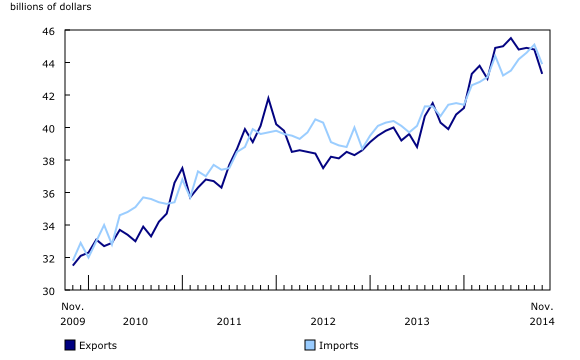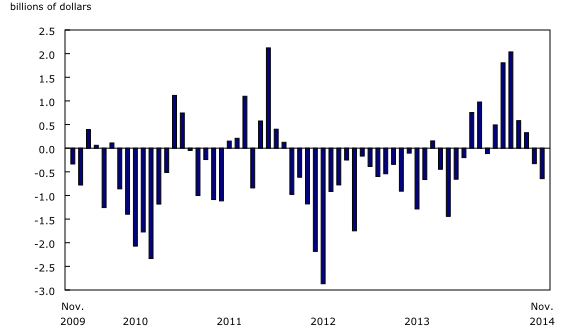Canadian international merchandise trade, November 2014
Archived Content
Information identified as archived is provided for reference, research or recordkeeping purposes. It is not subject to the Government of Canada Web Standards and has not been altered or updated since it was archived. Please "contact us" to request a format other than those available.
Released: 2015-01-07
Canada's exports declined 3.5% in November and imports were down 2.7%. As a result, Canada's merchandise trade deficit with the world widened from $327 million in October to $644 million in November.
Export prices declined 1.9% and volumes were down 1.6%. Meanwhile, import prices declined 1.0% and volumes decreased 1.7%.
Lower exports to the United States and the United Kingdom
Exports to the United States decreased 2.6% to $32.9 billion in November. Exports to countries other than the United States fell 6.2% to $10.4 billion; the main contributor was the United Kingdom, down $787 million. Partially offsetting the decline were increased exports to Mexico, up $280 million, and Hong Kong, up $216 million.
Imports from the United States declined 2.1% to $29.9 billion. Imports from countries other than the United States decreased 4.2% to $14.0 billion. Imports were down from Belgium (-$133 million), China (-$129 million) and Saudi Arabia (-$114 million).
As a result, Canada's trade surplus with the United States narrowed from $3.2 billion in October to $2.9 billion in November. Canada's trade deficit with countries other than the United States widened from $3.5 billion in October to $3.6 billion in November.
Decline in exports of energy products as well as metal and non-metallic mineral products
Exports declined to $43.3 billion in November, the lowest level since April 2014. The main contributors to the decrease were energy products and metal and non-metallic mineral products. Notably, 9 of 11 sections declined. Nevertheless, year over year, exports were up 8.4%.
Exports of energy products fell 7.8% to $9.5 billion in November, the sixth consecutive monthly decrease. Crude oil and crude bitumen was the main contributor to the decline, down 9.9% to $6.9 billion, as prices fell 6.7% and volumes were down 3.4%. Exports of other energy products (-28.4%), mainly coal, also decreased.
Metal and non-metallic mineral products declined 8.3% to $5.0 billion. Overall, prices decreased 6.6% and volumes 1.9%. The decrease in exports was almost entirely due to a 26.2% decline in unwrought precious metals and precious metal alloys, which was partially offset by a 26.0% increase in unwrought nickel and nickel alloys.
Widespread declines in imports
Imports decreased to $43.9 billion in November, the lowest level since July 2014. There were declines in 10 of 11 sections, with the largest decreases recorded in aircraft and other transportation equipment and parts; electronic and electrical equipment and parts; and consumer goods. Motor vehicles and parts (+1.2%) was the lone section to record an increase.
Imports of aircraft and other transportation equipment and parts fell 18.7% to $1.4 billion. Imports of aircraft decreased 47.3% to $269 million following two consecutive monthly increases. The commodity grouping "ships, locomotives, railway rolling stock, and rapid transit equipment" also contributed to the decline, down $173 million to $48 million in November following an increase of $183 million in October.
Electronic and electrical equipment and parts declined 5.8% to $4.8 billion, entirely on lower volumes. The main contributors to the decline in imports were communications and audio and video equipment (-13.1%) as well as computers and computer peripheral equipment (-8.5%).
Imports of consumer goods fell 3.0% to $9.0 billion in November, following a record high in October. The commodity grouping "miscellaneous goods and supplies" decreased 13.5% to $1.6 billion. In the section as a whole, volumes declined 3.2%.
Note to readers
Merchandise trade is one component of Canada's international balance of payments (BOP), which also includes trade in services, investment income, current transfers as well as capital and financial flows.
International trade data by commodity are available on both a BOP and a customs basis. International trade data by country are available on a customs basis for all countries, and on a BOP basis for Canada's 27 principal trading partners (PTPs). The list of PTPs is based on their annual share of total merchandise trade—imports and exports—with Canada in 2012. BOP data are derived from customs data by making adjustments for factors such as valuation, coverage, timing and residency. These adjustments are made to conform to the concepts and definitions of the Canadian System of National Accounts.
For a BOP versus customs-based data conceptual analysis, see "Balance of Payments trade in goods at Statistics Canada: Expanding geographic detail to 27 principal trading partners."
Data in this release are on a BOP basis, seasonally adjusted and in current dollars. Constant dollars are calculated using the Laspeyres volume formula (2007=100).
For more information on seasonal adjustment, see Seasonally adjusted data – Frequently asked questions.
Revisions
In general, merchandise trade data are revised on an ongoing basis for each month of the current year. Current year revisions are reflected in both the customs and BOP based data.
The previous year's customs data are revised with the release of the January and February reference months as well as on a quarterly basis. The previous two years of customs based data are revised annually and are released in February with the December reference month.
The previous year's BOP based data are revised with the release of the January, February and March reference months. To remain consistent with the Canadian System of macroeconomic accounts, revisions to BOP based data for the previous four years are released annually in December with the October reference month.
Factors influencing revisions include late receipt of import and export documentation, incorrect information on customs forms, replacement of estimates produced for the energy section with actual figures, changes in classification of merchandise based on more current information, and changes to seasonal adjustment factors.
For more information on revisions for crude oil and natural gas, see "Revisions to trade data for crude oil and natural gas."
Revised data are available in the appropriate CANSIM tables.
These data are now available in the Canadian International Merchandise Trade Database (Catalogue number65F0013X). From the Browse by key resource module of our website, choose Publications.
The November 2014 issue of Canadian International Merchandise Trade, Vol. 68, no. 11 (Catalogue number65-001-X), is also available from the Browse by key resource module of our website under Publications.
Data on Canadian international merchandise trade for December 2014 will be released on February 5, 2015.
Contact information
For more information, contact us (toll-free 1-800-263-1136; 514-283-8300; infostats@statcan.gc.ca).
To enquire about the concepts, methods or data quality of this release, contact Nita Boushey (613-951-3174), International Accounts and Trade Division.
- Date modified:



